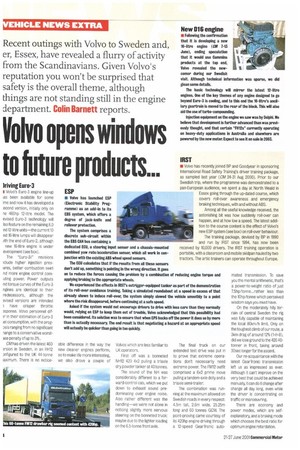Volvo opens windows to future products...
Page 14

If you've noticed an error in this article please click here to report it so we can fix it.
hiving Euro-3 I Volvo's Euro-3 engine line-up as been available for some ime and now it has developed a econd version, initially only on he 460hp 12-litre model. The evised Euro-3 technology will to feature on the remaining 8.0 nd 12-litre units—the current 10 nd 16-litre lumps will disappear iith the end of Euro-2, although
new 16-litre engine is under evelopment (see box).
The "Euro-3X" revisions iclude higher iruection prosures, better combustion swirl nd more engine control comuting power. Power outputs nd torque curves of the Euro-3 ngines are identical to their redecessors, although the 3vised versions are intended ) have crisper throttle ?.sponse. Volvo personnel difir in their estimation of Euro-3 el consumption, with the progDSiS ranging from no significant lenge to a conservative worstase penalty of up to 3%.
CM has driven the latest 460 .rsion in Sweden, in an FH12 )nfigured to the UK 44-tonne laximum. There is no notice able difference in the way the new cleaner engines perform, so to make life more interesting, we also drove a couple of Volvos which are less familiar to UK operators.
First off was a bonneted NH12 420 4x2 pulling a triaxle dry powder tanker at 40 tonnes.
The sound of the NH was considerably different to a forward-control cab, which we put down to exhaust sound predominating over engine noise. Also rather different was the handling—we were not alone in noticing slightly more nervous steering on the bonneted truck; maybe due to the lighter loading on the 6.5-tonne front axle. The final truck on our extended test drive was put in to prove that extreme operations don't necessarily need extreme power. The FM12 outfit comprised a 6x2 prime move pulling a tandem-axle dolly and a triaxle semi-trailer.
The combination was running at the maximum allowed on Swedish roads in every respect: 4.5m tail, 2.6m wide, 25.25m long and 60 tonnes GCW. The point-proving came courtesy of its 420hp engine driving through a 12-speed GearTronic auto mated transmission. To save you the mental arithmetic, that's a power-to-weight ratio of just 7.5hp/tonne...rather less than the 10hp/tonne which perceived wisdom says you must have.
On the moderately hilly terrain of central Sweden the rig was fully capable of maintaining the local 80km/h limit. Only on the toughest climb of our route, a 3km drag of around 12% (1-in-8), did we lose ground to the 420 40tonner in front, taking around 30sec longer for the ascent.
Our re-acquaintance with the latest GearTronic transmission left us as impressed as ever. Although it can't improve on the very best that could be achieved manually, A can do it change after change all day long, even while the driver is concentrating on traffic or manoeuvring.
There are economy and power modes, which are selfexplanatory, and and a braking mode which chooses the best ratio for optimum engine retardation.
































































































